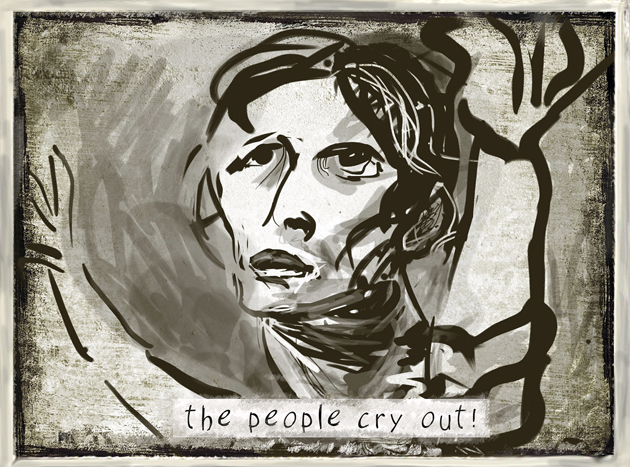Collaborative Meaning-making in Arts-based Research: Data Interpretation with an Artist, a Physician, and an Art Historian
DOI:
https://doi.org/10.18432/R2MW28Keywords:
arts-based research, collaborative meaning-making, anatomical drawing, female reproductive system, medical student, playful association, improvisation, humor, embarrassmentAbstract
This article discusses collaborative meaning-making in arts-based research. It introduces a project in which an artist-researcher invited a physician and an art historian to help to interpret medical students’ hand-made drawings of the female reproductive system and the conception process. The authors elaborated on different viewpoints and modes of talking during the data interpretation, and discussed how these were founded on, and disrupted, their professional roles in various ways. The article discusses how these different viewpoints about the students’ drawings complemented or conflicted with each other. It also discusses the use of associations and humor in these interpretations, and the experiences of emotional discomfort during the process.
References
Ahern, Kathryn J. (1999). Ten tips for reflexive bracketing. Qualitative Health Research, 9(3), 407-411.
Allen, Joyce. (1998). Bearing the burden or baring the soul: Physicians’ self-disclosure and boundary management regarding medical mistakes. Health Communication, 10(2), 175-197.
Berger, Roni, & Malkinson, Ruth. (2000). “Therapeutizing” research: The positive impact of research on participants. Smith College Studies in Social Work, 70(2), 307-314.
Breuer, Franz. (2000). Qualitative methods in the study of biographies, interactions and everyday life contexts: The development of a research style. Forum: Qualitative Social Research, 1(2), Art. 3.
Denzin, Norman K. (2001). The reflexive interview and a performative social science. Qualitative Research, 1(1), 23-46.
Frank, Arthur W. (2005). What is dialogical research, and why should we do it? Qualitative Health Research, 15(7), 964-974.
Goffman, Erving. (1959). The presentation of self in everyday life. Garden City, New York: Doubleday.
Hunter, Anita; Lusardi, Paula; Zucker, Donna; Jacelon, Cynthia; & Chandler, Genevieve. (2002). Making meaning: The creative component in qualitative research. Qualitative Health Research, 12(3), 388-98.
Koski, Kaisu. (2013). As-if the patient were in the classroom: Video-based enquiry into the absent body in medical education. Journal of Applied Arts & Health 4(2), 207–222.
Koski, Kaisu. (2014). Mapping the female reproductive system: Arts-based Inquiry of Medical Students’ Anatomy Drawings. Studies in Material Thinking 10.
Martin, Emily. (1996) Medical metaphors of women’s bodies: Menstruation and menopause. In M. Emily (Ed.), The Woman in the Body. Boston: Beacon Press.
Montuori, Alfonso. (2003). The complexity of improvisation and the improvisation of complexity: Social science, art and creativity. Human Relations, 56(2): 237-255.
Nichols, Shaun, & Stich, Stephen P. (2003). Mindreading: An integrated account of pretense, self-awareness, and understanding other minds. Oxford, U.K.: Clarendon Press.
Paulus, Trena M.; Woodside, Marianne; & Ziegler, Mary F. (2010). “I tell you, it’s a journey, isn’t it?” Understanding collaborative meaning making in qualitative research. Qualitative Inquiry. 16(10), 852-862.
Russell, Glenda M., & Bohan, Janis S. (1999). Hearing voices: The uses of research and the politics of change. Psychology of Women Quarterly, 23(2), 403-418.
Russell, Glenda M., & Kelly, Nancy H. (2002). Research as interacting dialogic processes: Implications for reflexivity. Forum: Qualitative Social Research, 3:3.
Saldaña, Johnny. (1998). Ethical issues in an ethnographic performance text: The “dramatic impact” of “juicy stuff.” Research in Drama Education: The Journal of Applied Theatre and Performance, 3(2), 181-196.
Silver, M.; Sabini, J.; & Parrott, G. (1987). Embarrassment: A dramaturgic account. Journal for the Theory of Social Behavior, 17(1), 47-61.
Sperber, Dan. (2000). Introduction. In D. Sperber (Ed.), Metarepresentations: A multidisciplinary perspective. Oxford, U.K.: Oxford University Press.
The animation Not to scale at all can be viewed at: http://www.kaisukoski.com/about/not-to-scale-at-all
Published
How to Cite
Issue
Section
License
Copyright (c) 2016 Art/Research International: A Transdisciplinary Journal

This work is licensed under a Creative Commons Attribution-NonCommercial-NoDerivatives 4.0 International License.
Authors who publish with Art/Research International agree to the following terms:
a. Authors retain copyright and grant the journal right of first publication and the right to sublicense the Contribution, in the form in which it is published by the journal, to others under the terms and conditions of the of the Creative Commons Attribution-NonCommercial-NoDerivs (CC BY-NC-ND) that allows others to download the work and share the work with others with an acknowledgement of the work's authorship and initial publication in this journal, but they cannot change the work in any way or use any part of the work commercially.
b. Authors are able to enter into separate, additional contractual arrangements for the non-exclusive public distribution and display of the journal's published version of the work (e.g., post it to an institutional repository or publish it in a book), with an acknowledgement of its initial publication in this journal.
c. Authors are permitted and encouraged to post their work online (e.g., in institutional repositories or on their website) prior to and during the submission process, as it can lead to productive exchanges, as well as earlier and greater citation of published work (See The Effect of Open Access).
d. Authors wishing to include items (such as images or other media, or any creative works of others whether previously published or not) must contact the original copyright holder to obtain explicit permission to publish these items in Art/Research International. Writing permission should include: the title(s) of any copyrighted work, original place of publication if applicable, and an acknowledgement of having read Art/Research International's copyright notice. Authors are responsible for obtaining this permission and keeping it in their own records for later verification.



